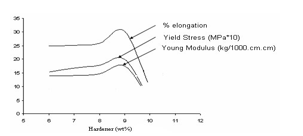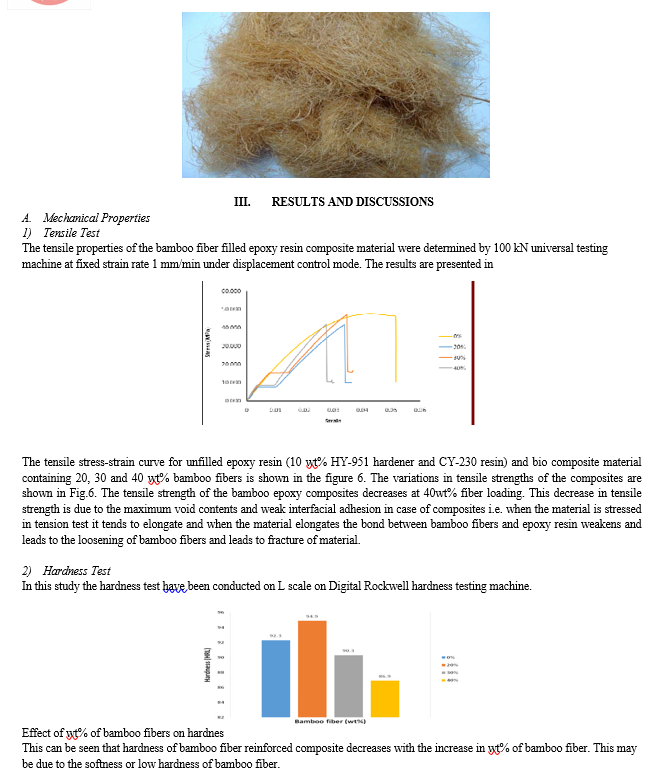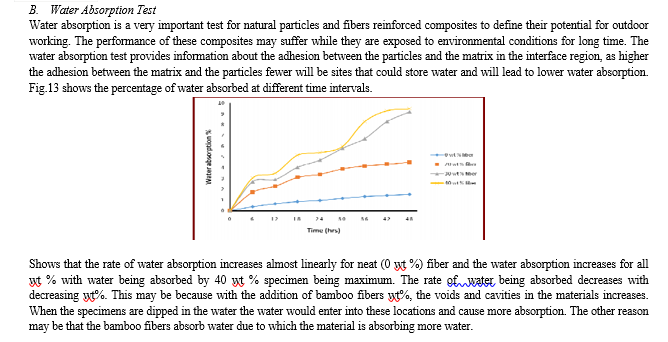Ijraset Journal For Research in Applied Science and Engineering Technology
- Home / Ijraset
- On This Page
- Abstract
- Introduction
- Conclusion
- References
- Copyright
Fabrication of Fiber Reinforced Composite Material Using Bamboo Fiber, Glass Fiber and Polyester
Authors: Mr. Jawed Rafiq , Abhishek Pal, Ajay Kumar, Abhishek Kumar Bharti, Abdul Hakim Khan
DOI Link: https://doi.org/10.22214/ijraset.2023.52168
Certificate: View Certificate
Abstract
Sheet Composites are essential for the aerospace, space, and automotive industry. In fact, a lot of structures and high-performance machines incorporate composites into their design. There are plenty of companies in India who perform composite analysis and manufacturing. Having knowledge and experience in the design and fabrication of composite material increases the employ-ability of an engineer. In this project, you are going to fabricate a composite material in which multiple materials will be used as fiber. This will help you gaining knowledge of composite material too.There are many processes to fabricate a composite material, such as hand lay-up, automated lay-up, spray-up, filament winding, protrusion, resin transfer molding etc. but hand layup method is easy and cost-effective. You will use this process to fabricate this composite material. After fabricating the sample, you need to perform the Tensile test and Compressive test by making standard specimens of your sample in Charpy impact test machine.
Introduction
I. INTRODUCTION
Composites are essential for the aerospace, space, and automotive industry. In fact, a lot of structures and high-performance machines incorporate composites into their design. There are plenty of companies in India who perform composite analysis and manufacturing. Having knowledge and experience in the design and fabrication of composite material increases the employability of an engineer. In this project, you are going to fabricate a composite material in which multiple materials will be used as fiber. This will help you gaining knowledge of composite material too.
Bamboo, Flex and Glass fiber are easily available materials and a great addition to the reinforcement phase of the composite material. Strengthening the reinforcement phase increases the strength of the composite significantly
There are many processes to fabricate a composite material, such as hand lay-up, automated lay-up, spray-up, filament winding, pultrusion, resin transfer molding etc. but hand layup method is easy and cost-effective. You will use this process to fabricate this composite material. After fabricating the sample, you need to perform the Tensile test and Compressive test by making standard specimens of your sample in Universal Testing Machine.
- Composite Material: Materials like Iron, Steel are better in tension but poor in compression, similarly Wood, Cast Iron is better in compression but poor in tension. To gain the benefit of having more such properties in one material we combine two or more materials in some arrangement. These types of materials are called composite materials.
- Fibre Reinforced Composites: Fibre reinforced composites have been widely successful in hundreds of applications where there was a need for high strength materials. There are thousands of custom formulations which offer FRP a wide variety of tensile and flexural strengths. When compared with traditional materials such as metals, the combination of high strength and lower weight has made FRC an extremely popular choice for improving a product’s design and performance.
- Bamboo Fiber: Bamboo fibre is a regenerated cellulosic fibre produced from bamboo. Starchy pulp is produced from bamboo stems and leaves through a process of alkaline hydrolysis and multi-phase bleaching.
- Flex: Natural fibres are subdivided into different classes with flax being a bast fibre. Bast fibers bear the potential for industrial use based on their toughness and structural contribution. It has outstanding mechanical properties plus local availability. This will be a great addition to the reinforcement phase of your composite.
- Glass Fiber: Glass fiber is also known as fiberglass. It is material made from the extremely fine fiber of glass Fiberglass is a lightweight, extremely strong, and robust material.
- Ployester: The polyester materials, while less costly, have lower strength characteristics and are less heat and weather resistant. As such though, they are the most widely used in commercial products. The epoxy, bismaleimide, phenolic, and polyimide matrix materials exhibit superior mechanical properties and heat resistance quality.
II. STUDY AREA & COLLECTION
A. Study Area
Natural fiber reinforced polymer composites have raised a great attention and interest among scientists and engineers in recent years due to the consideration of veloping environmental friendly materials . They are high specific strength and modulus materials, low priced, recyclable and are easily available. It is known that natural fibers are non-uniform with irregular cross sections which make their structures quite unique and much different with man-made fibers such as glass fibers, carbon fibers etc .Various researchers have worked on the natural fibers containing polyolefins, polystyrene, polyester and epoxy resins. Properties like low cost, light-weight, high specific strength, free from health hazard are the unique selling points of these composites. Though the presence of hydroxyl and other polar groups in the natural fibers leads to the weak interfacial bonding between the fibers and the hydrophobic polymers, these properties can be significantly improved by interfacial treatment . Among the various natural fibers, bamboo fiber is a good candidate for use as natural fibers in composite materials. Jindal has observed that tensile strength of bamboo-fiber reinforced plastic (BFRP) composite is comparatively equivalent to that of the mild steel, whereas their density is only 12% of that of the mild steel. Hence, the BFRP composites can be extremely useful in structural applications. Jain and Kumar have investigated that a uniform strength can be achieved in all directions of the composites by using multidirectional orientation of fibers. Considerable interest has been generated in the manufacturing of thermoplastic composites due to their good fracture toughness and thermal stability With more stringent demands for recycling standards, thermoplastic polymers are substituting thermosetting polymers as matrix materials for high volume consumer-driven composites . Thermoplastic matrix composites materials offer an extended solution in different applications in automotive industry, construction, electrical appliances and home/urban furniture.
B. Collection
20*10*2cm (sample) =(400cc)
- Step-1(Reinforcement measure)
5% Rainforcement (20cc)
|
Materials |
Glass |
Bamboo |
Polyester |
|
|
1.4g/cc |
0.6g/cc |
1.38g/cc |
|
Volume |
2cm |
1cm |
1cm |
|
1.442+0.6+1.38=3cc |
|||
By volume(60:30:10)
|
Material |
Glass |
Bamboo |
Polyester |
|
Volume |
12cc |
6cc |
2cc |
|
Weight |
168kg |
3.6kg |
2.7kg |
2. Step-2(Matrix = 380cc)
Resin = 2/3*380 = 2508cc
Hardner =1/3*380 = 126.54cc

Effect of wt% of Hardener (Modi Tide) on Mechanical Properties
C. Methdology
- To fabricate the composite first, you have to collect bamboo from your locality. Then you have to wash it thoroughly so that no impurities will be there
- After completing the above process, you have to dry the Bamboo nearly a day to remove any moisture present in it. Then you have to perform alkali solution treatment to kill bacteria present in it
- Then you have to cut alkali treated Bamboo into small fibers using the cutter
- Make a square box with one side open, using wood or Cast iron with dimension 100*100*20mm. This box will be used as a mold for fabricating your composite.
- Then use polyethylene at the bottom of the mold to get the good surface finish
- Then start adding one layer of polyester and upon which put fibers layer by layer. Keep repeating this step, until you get desired thickness.
- After this apply equal pressure throughout the mold so that both the material mixes together to form an effective composite material.
- Then wait for few hours so that the mixture in the mold dries down and your composite is ready for tasting purpose.
- Then make a few sample specimens for performing the various test. At least Make 3 standard specimen for each test.
- Perform a tensile test using a UTM machine to find ultimate tensile strength, breaking strength, maximum elongation, and reduction in area. From these measurements, you can determine Young's modulus, Poisson's ratio, yield strength, and strain-hardening characteristics.
- Then perform the compressive test in the same machine to find out ultimate compressive strength, breaking strength etc.
- Compare both ultimate tensile test and compressive test of your composite with the strength of parent materials.
D. Fabrication of Bamboo Fiber



IV. RECOMMENDATIONS
Manufacturers and engineers are always on the look for the new materials and improved processes to use in the manufacturing of better products, and thus increase their profit margin. The developed composites are a good substitute for a number of petroleum based products and form a very much sustainable resource. They have lot of advantages like low density, low price, recyclable, biodegradable, low abrasive wear, CO2 neutral and environment friendly. Natural fiber composites are being used in a large number of applications in automotive, constructions, marine, electronic and aerospace. These composite have a lot potential as a low cost polymeric composite material for tri bological applications also. Bamboo epoxy composites form a new class of bio-fiber reinforced composites, which may find potential applications in:
- Conveyor belt rollers.
- Passenger seat frames (replacing wood/steel) in railway coaches / automobiles
- Pipes carrying pulverized coal in power plants
- Pump and impeller blades
- Household furniture and also as low cost housing materials.
- Helicopter fan blades
- Trim parts in dashboards
- Door panels and Seat Cushions
- Parcel shelves
- Seat cushions 165
- Backrests and Cabin linings.
V. FUTURE SCOPE OF WORK
Bamboo-Epoxy composites have a lot of research potential, considering the present day environmental concerns.
The work of the present thesis can be extended by a number of different ways. Considering the raw materials, unidirectional short bamboo fibres has been used for fabrication of the composites in the present work. However bi-directional bamboo can also be used as reinforcement in the composites. Fiber length can be one of the
variables in the composite fabrication and their effect can be studied on the mechanical, chemical and erosive properties. Other thermosetting polymers like polyesters polyurethane and thermoplastics like polypropylene can also be used as resins in the bamboo based polymer composites. As far as the fabrication method is concerned, the hand up lay up method has been used for fabrication of composites in the present work. It is recommended
that the use of injection moulding to fabricate composites samples for testing is more precise and it reduces much of human errors. The chemical resistance and water absorption of composites have been studied in the present work; however the effect of temperature on the water absorption can be explored as future work. Effect
of chemicals on the mechanical properties of the composites can also be a good problem to study. Other chemical properties like Moisture absorption and swelling behavior of bamboo epoxy composites can also be studied wear behavior of composite can also be explored.
Conclusion
Bamboo fiber reinforced epoxy composites have been fabricated with varying fiber concentration. The experimental analysis has shown that bamboo fiber reinforcement in the epoxy matrix has improved the mechanical properties of composite structure. The composites have been fabricated using the hand-lay-up method, which is one of the simplest methods to fabricate the composites under normal conditions. The fabricated composites are of good quality with appropriate bonding between the fiber and resin. However the presence of voids is unavoidable in composite fabrication, particularly through hand-lay-up route. The presence of pores and voids in the composite structure significantly affect a number of mechanical properties and even the performance of the composites. Higher void contents usually mean lower fatigue resistance and greater susceptibility to water penetration. While studying the fiber variations, the increase in fiber loading has improved the hardness but reduced the tensile strength and flexural strength of the composites. This decrease is attributed to the inability of the fiber to support the stress transferred from the polymer matrix. Also the poor interfacial bonding generates partial spaces between the fiber and matrix material, hence resulting in a weak structure. Impact strength of composites also increased up to 20wt% fiber loading and then decreased at 30wt%fiber loading. Reduction of impact strength at 30wt% fiber loading was due to micro-spaces between the fiber and matrix polymer, and as a result causes numerous micro-cracks when impact occurs, which induce crack propagation easily and decrease the impact strength of the composites. Absorption of composites in water has been tested. Percentage absorption of chemicals in bamboo epoxy composite increased with increase in fiber content. Water absorption of composites increased with increase in fiber loading. The hydrophilic nature of bamboo fibers is responsible for water 161 absorption. Water absorption of particulate filled composites has been found to be less than the unfilled composites.
References
[1] A Abdalla, Ab. Rashdi, Mohd Sapuan Salit, Khalina Abdan and Megat Mohamad Hamdan Megat , (2010) Water Absorption Behaviour of Kenaf Reinforced Unsaturated Polyester Composites and Its Influence on Their Mechanical Properties. Journal of Science & Technology, Vol.18 (2), pp.433 -440. [2] A.Varada rajulu, G. Babu Rao and R Lakshminarayana Reddy (2001) Chemical Resistance and Tensile Properties of Epoxy/Polycarbonate Blend Coated Bamboo fibres, Journal of Reinforced Plastic and Composites, Vol. 20 (4), pp.335-340. [3] A K Rana, A Mandel, B C Mitra, R Jacobson, R Rowel, A N Banerjee (1998) Short jute fiber-reinforced polypropylene composites: Effect of compatibilizer, Journal of Applied Polymer Science, Vol.69, pp.329-338. [4] D. Nabi Sahieb, J.P. Jog, 1999, “Natural fiber polymer composites, a review”, Advances in Polymer Technology, Vol. 18, No. 4, , pp.351–363. Innovative Systems Design and Engineering www.iiste.org ISSN 2222-1727 (Paper) ISSN 2222-2871 (Online) Vol.6, No.1, 2015 [5] H. Kumar, Siddaramaiah, 2005, “Study of Chemical and Tensile Properties of PU and PU/PS Coated Bamboo Fibers”, Polymer-Plastics Technology and Engineering, Vol. 44, pp.1369–1377. [6] H Nitz, P Reichert, H Ro Mling, and R.Mulhaupt (2000) Influence of compatibilizers on the surface hardness, water uptake and the mechanical properties of poly(propylene) wood flour composites prepared by reactive extrusion. Macromolecular Material and Engineering, Vol. 276/277, pp.51-58. [7] Hitoshi Takagi and Yohie Ichihara (2004) Effect of fiber length on mechanical properties of green composites using starch based resin and short bamboo fibers. ISME International journal, Series A Vol.47, No.4, pp.551- 555. [8] J Simonsen, R Jacobson, R Rowell (1998) Properties of Styrene-Maleic Anhydride Copolymers Containing Wood-Based Fillers. Forest Product Journal, Vol.48, pp.89-92. [9] J. M. G. Martiner, J. Taranco, O. Laguna, and E. P. Collar (1994) Modification of Polypropylene by Maleic Anhydride. Study on the Reaction Conditions Using a Batch Process. International. Polymer. Processing IX, Vol. 3, pp.246-251; [10] J S Han, (1998) Properties of Non wood fibers. Proceedings of the Korean Society of Wood Science and Technology, 3 [11] Kazua Okubo, Toru Fuzii, Naoya Yamashita (2005) Improvement of interfacial adhesion in bamboo polymer composite enhanced with micro fibrillated cellulose. JSME International journal, Series A, Vol.48, No.4, pp.199-20. [12] K. Joseph, S. Varghese, G. Kalaprasad, S. Thomas, L. Prasannakumari, P. Koshy, and C. Pavithran (1996) Influence of Interfacial Adhesion on the Mechanical Properties and Fracture Behaviour of Short Sisal Fibre Reinforced Polymer Composites. Europeon Polymer Journal, Vol.32, pp.1243–1250. [13] Mehdi Tajvidi, Saeed Kazemi Najafi and Nazanin Moteei (2006) Long-Term Water Uptake Behavior of Natural Fiber/Polypropylene Composites. Journal of Aplied Polymer Science, Vol. 99, pp.2199-2203. [14] Moe Moe Thwea, Kin Liao (2003) Durability of bamboo-glass fiber reinforced polymer Matrix hybrid composites. Composites Science and Technology, Vol.63, pp.375–387. [15] Moe Moe Thwea, Kin Liao (2002) Effect of environmental aging on the mechanical properties of bamboo glass reinforced polymer matrix hybrid composites. Composites: Part A Applied Science and Manufacturing, Vol. 33, pp.43-52. [16] Mi Yongli, Xiaoya Chen, Qipeng Guo (1997) Bamboo Fiber-reinforced Polypropylene Composites: Crystallization and Interfacial Morphology. Journal of Applied polymer Science, Vol. 64, pp.1267-1273. [17] Mohini Saxena and V. Sorna Gowri (2003) Studies on Bamboo Polymer Composites with Polyester Amide Polyol as Interfacial Agent. Polymer composites, Vol. 4, No.3, pp.428-436. [18] M.M. Sain, C. Imbert, and B.V. Kokta, (1993) Composites of Surface Treated Wood Fibre and Recycled Polypropylene. Die Angew, Macromolecule Chemistry, Vol. 210(3588), pp.33–46. [19] M.M. Sain, and B.V. Kokta (1994) Structure Property Relationship of Wood Fibre Filled Polyproylene Composites. Polymer Plastic Technology and. Engg. Vol. 33, pp.89–104. [20] Paul Wambua, Jan Ivens, Ignaas Verpoest (2003) Natural fibres: can they replace glass in fibre reinforced plastics. Composites Science and Technology, Vol.63, pp. 1259–1264. [21] R M Rowell, A M Tillman, R Simonson (1986) A Simplified Procedure for the Acetylation of Hardwood and Softwood Flaxes for Flake board Production. Journal of Wood Chemistry and Technology, Vol.6, pp.427- 448. [22] R M Rowell, A R Sanadi, D F Caulfield, R E Jacobson (1997) Utilization of Natural Fibers in Plastic Composites: Problems and Opportunities. In Lignocellulosic- Plastics Composites; A L Leao, F X Carvalho, E Frollini, Eds.; University of Sao Paulo: Brazil,. [23] Ryoko Tokoro,Duc Minh Vu, Kazuya Okubo, Tatsuya Tanaka, Toru Fujii, Takayasu Fujiura (2008 ) How to improve the mechanical properties of polylactic acid with bamboo fibers. Journal of Material Science, Vol.43, pp.775-787. [24] Seema Jain, Rakesh Kumar (1992) Mechanical behaviour of bamboo and bamboo composite. Journal of Material Science, Vol.27, pp.4598- 4604. [25] Seema Jain, U C. Jindal, Rakesh Kumar (1993) Development and fracture mechanism Of bamboo /polyester resin composite. Journal of Materials Science Letters, Vol. 12, pp. 558-560. [26] Seung Hwan Lee, Tsutomu Ohkita (2004) Bamboo fiber (BF)-filled poly (butylenes Succinate) biocomposites-Effect of BF-e-MA on the properties and crystallization Kinetics. Holzforschung, Vol.58, pp.537-543. [27] S Panthapulakkal, M Sain (2007) Injection-Molded Short Hemp Fiber/Glass Fiber-Reinforced Polypropylene Hybrid Composites- Mechanical, Water Absorption and Thermal Properties. Journal of Applied Polymer Science, Vol. 103, pp. 2432-2441.
Copyright
Copyright © 2023 Mr. Jawed Rafiq , Abhishek Pal, Ajay Kumar, Abhishek Kumar Bharti, Abdul Hakim Khan. This is an open access article distributed under the Creative Commons Attribution License, which permits unrestricted use, distribution, and reproduction in any medium, provided the original work is properly cited.

Download Paper
Paper Id : IJRASET52168
Publish Date : 2023-05-13
ISSN : 2321-9653
Publisher Name : IJRASET
DOI Link : Click Here
 Submit Paper Online
Submit Paper Online

